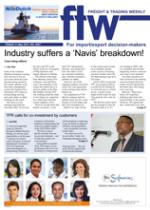As Transnet Freight Rail
ramps up efficiency
through its Market Demand
Strategy, SA Inc has equal
responsibility to do the same.
“Customers too need to
come to the party in terms of
infrastructure investment.,”
TFR CEO Siyabonga
Gama told delegates at a
Johannesburg Chamber of
Commerce and Industry
breakfast in Johannesburg last
week as he updated industry
on the R201-billion MDS.
“We have to ensure
that the customer does not
become the bottleneck – and
for that there needs to be
co-investment.”
Gama pulled no punches
about TFR’s legacy of nonperformance,
but in his view
investment in infrastructure
and development is beginning
to pay dividends in improved
efficiency and predictability
– and consequently increased
market share.
The scene was set for
the rail utility’s battle with
inadequate and ageing assets
in the 80s when declining
volumes in sanctionshit
South Africa led to a
deceleration in investment.
“In 1994 when the wheel
turned there was a lot of
congestion in the ports.
Suddenly overnight people
started trading with us and
we had to wake up quickly.
But you don’t wake up
quickly from a deep sleep,”
said Gama.
Loss of market share was
the logical consequence and
that’s the battle that TFR is
determined to win through
its investment in equipment,
skills training and the
creation of a new culture of
performance excellence.
Historically, container
business has not been a
focus, said Gama.
“While the port authorities
were investing in containers,
the railways were investing
in the iron ore and coal lines
so there was no convergence
in the types of investment.”
TFR has now adjusted
its focus and GFB, which
peaked in the 80s at 94mt
and has been declining ever
since, is a key focus.”
“We’ve now realised that
rail is a volume business
and that you need to be
able to grow volumes to
reduce unit costs and make a
contribution to fixed costs
“We realised that there
was 40% of untapped GFB
market potential because we
had not invested in assets,
rolling stock or people. We
had 11% market share and
we knew we could lift that to
25-30%.
“We told Transnet
that we shouldn’t run the
business on the basis of
how much you are able to
finance. If you look at the
opportunities and you are
able to grow volumes, we
believed we should change
the philosophy around
infrastructure – and as a
result the MDS was born.
“But as we begin to invest
in railway infrastructure, SA
Inc needs to do the same.
Ultimately our customers
too need to invest in loading
sites, plant and equipment to
create an enabling logistics
value chain.
“We want to invest in
primary infrastructure to run
a railway and ports – and
that leaves plenty of ancillary
opportunity for the private
sector.”
CAPTION
Siyabonga Gama … ‘We must
ensure that the customer does
not become the bottleneck.’

